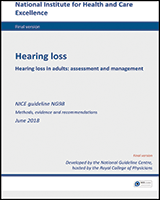NCBI Bookshelf. A service of the National Library of Medicine, National Institutes of Health.
National Guideline Centre (UK). Hearing loss in adults: assessment and management. London: National Institute for Health and Care Excellence (NICE); 2018 Jun. (NICE Guideline, No. 98.)
3.1. What is a NICE guideline?
NICE guidelines are recommendations for the care of individuals in specific clinical conditions or circumstances within the NHS – from prevention and self-care through primary and secondary care to more specialised services. These may also include elements of social care or public health measures. We base our guidelines on the best available research evidence, with the aim of improving the quality of healthcare. We use predetermined and systematic methods to identify and evaluate the evidence relating to specific review questions.
NICE guidelines can:
- provide recommendations for the treatment and care of people by health professionals
- be used to develop standards to assess the clinical practice of individual health professionals
- be used in the education and training of health professionals
- help patients to make informed decisions
- improve communication between patient and health professional.
While guidelines assist the practice of healthcare professionals, they do not replace their knowledge and skills.
We produce our guidelines using the following steps:
- A guideline topic is referred to NICE from NHS England.
- Stakeholders register an interest in the guideline and are consulted throughout the development process.
- The scope is prepared by the National Guideline Centre (NGC).
- The NGC establishes a guideline committee.
- A draft guideline is produced after the group assesses the available evidence and makes recommendations.
- There is a consultation on the draft guideline.
- The final guideline is produced.
The NGC and NICE produce a number of versions of this guideline:
- The ‘full guideline’ contains all the recommendations, plus details of the methods used and the underpinning evidence.
- The ‘NICE guideline’ lists the recommendations.
- ‘Information for the public’ is written using suitable language for people without specialist medical knowledge.
- NICE Pathways bring together all connected NICE guidance.
This version is the full version. The other versions can be downloaded from NICE at www.nice.org.uk.
3.2. Remit
NICE received the remit for this guideline from NHS England. NICE commissioned the NGC to produce the guideline.
The remit for this guideline is: to produce a guideline on the assessment and management of hearing loss (adult presentation).
3.3. Who developed this guideline?
A multidisciplinary guideline committee comprising health professionals and researchers as well as lay members developed this guideline (see the list of guideline committee members and the acknowledgements).
The National Institute for Health and Care Excellence (NICE) funds the National Guideline Centre (NGC) and thus supported the development of this guideline. The committee was convened by the NGC and chaired by Katherine Harrop-Griffiths in accordance with guidance from NICE.
The group met approximately every 6 weeks during the development of the guideline. At the start of the guideline development process all committee members declared interests including consultancies, fee-paid work, shareholdings, fellowships and support from the healthcare industry. At all subsequent committee meetings, members declared arising conflicts of interest.
Members were either required to withdraw completely or for part of the discussion if their declared interest made it appropriate. The details of declared interests and the actions taken are shown in appendix B.
Staff from the NGC provided methodological support and guidance for the development process. The team working on the guideline included a project manager, systematic reviewers (research fellows), health economists and information specialists. They undertook systematic searches of the literature, appraised the evidence, conducted meta-analysis and cost-effectiveness analysis where appropriate and drafted the guideline in collaboration with the committee.
3.3.1. What this guideline covers
The guideline covers the key areas of:
- Initial assessment (first presentation) and referral from primary care.
- Further assessment of hearing and communication needs.
- Management of hearing difficulties.
The following groups are covered:
- Adults (aged 18 years and older) with hearing loss, including those with onset before the age of 18 but presenting for the first time in adulthood.
For further details please refer to the scope in appendix A and the review questions in section 4.1.
3.3.2. What this guideline does not cover
The guideline does not cover:
- Tinnitus (without hearing loss).
- Vertigo (without hearing loss).
- Acute temporary hearing loss caused by traumatic head injuries, for example perforated tympanic membranes or middle ear effusions.
- Management of disease processes underlying hearing loss.
- Surgical management of hearing loss.
- Screening programmes for hearing loss.
The following groups are not covered:
- Adults who presented with hearing loss before the age of 18.
3.3.3. Relationships between the guideline and other NICE guidance
Related NICE technology appraisals
- Cochlear implants for children and adults with severe to profound deafness. NICE technology appraisal guidance 166 (2009).
Related NICE interventional procedures guidance
- Auditory brain stem implants. NICE interventional procedure guidance 108(2005).
Related NICE guidelines
- Patient experience in adult NHS services. NICE guideline CG138 (2012)
- Service user experience in adult mental health. NICE guideline CG136 (2011)
- Medicines adherence. NICE guideline CG76 (2009)
- Tinnitus NICE guideline (in development)
- Development of the guideline - Hearing loss in adultsDevelopment of the guideline - Hearing loss in adults
- Littorinimorpha 16S large subunit ribosomal RNA gene, partial sequence; mitochon...Littorinimorpha 16S large subunit ribosomal RNA gene, partial sequence; mitochondrial.PopSet: 28882485PopSet
Your browsing activity is empty.
Activity recording is turned off.
See more...
